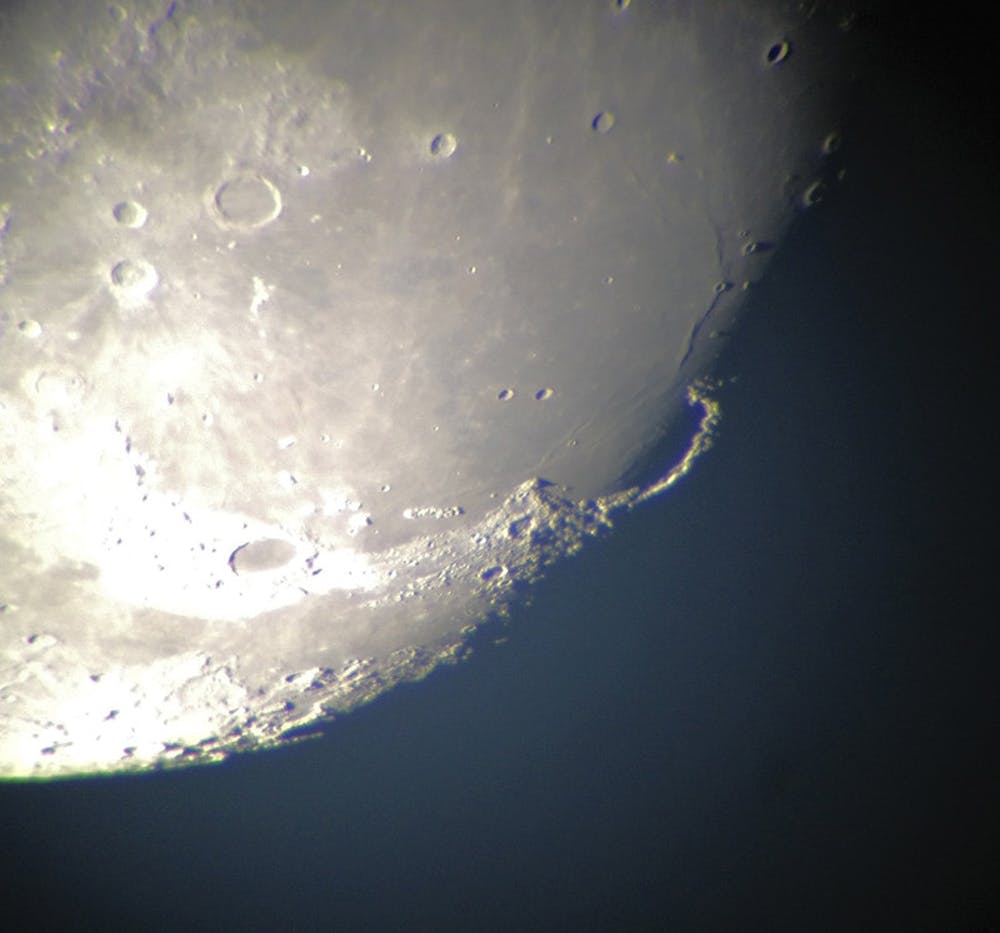For the first time, researchers have remotely detected evidence to suggest the existence of water under the surface of the moon.
A team of researchers led by Rachel Klima ’06 PhD’08 used remote imaging data to discover magmatic water — water locked in minerals — originating from deep within the moon. The findings, published Aug. 25 in Nature Geoscience, provide further evidence that not all lunar water comes from outside the moon and open possibilities for future space research.
Klima and her team used data gathered by NASA’s Moon Mineralogy Mapper — also known as the M3 — to determine the presence of magmatic water inside the lunar crater Bullialdus. The type of rock that holds magmatic water is normally only found deep within the moon but is thought to have been brought to the surface by the impact that formed the crater. This confirms the water trapped inside comes from within the moon rather than from the surface, the researchers concluded.
Klima was not initially looking for evidence of magmatic water. Instead, she was examining the composition of the rocks around the crater, she said. When she noticed some abnormal readings around the peak of the crater, she decided to give the area a more detailed look.
The discovery could signify a major turning point in lunar study. “The paradigm that we’ve had since the Apollo missions is that the moon is bone dry,” said Peter Schultz, professor of geological sciences and member of the NASA team that discovered frozen water at the moon’s south pole in 2009.
The presence of surface water on the moon previously has been attributed to external factors such as solar wind, which supported the idea that the moon was innately dry, Schultz said. The new evidence of magmatic water within the moon challenges this school of thought.
“To say that it is magmatic water means that we have to reconsider our models for the formation of the moon,” Schultz added.
With this discovery also comes the question of whether the water detected in the crater’s central peak is definitely lunar in origin. Solar wind has been ruled out as the source for the water because of the relatively highly concentrated levels of hydroxyl detected within the peak.
“It’s also an impact crater,” Schultz said, “and so the question is — could the water have been delivered and simply trapped?”
Klima said the odds of this possibility are “very unlikely because typically very little of the impacter will survive that kind of an event.” She added that any remaining matter would probably be distributed elsewhere in the crater as opposed to near the central peak.
The M3 imager works by measuring infrared light reflected off the surface of the moon. Researchers observe the absorption rate and conclude the composition of the surface.
“Where we have bright reflectance, there is no absorption. And where we have things like bonds bending and vibrating, the light gets absorbed and so you have a drop in the reflectance,” Klima said. The detection of hydroxyl, a substructure of the water molecule, is key to concluding whether water is present.
The data Klima and her team analyzed was gathered by an M3 on India’s Chandrayaan-1 spacecraft, which was sent into space in 2008.
The project was the result of “intense activity by scientists and engineers in the U.S. and India over several years,” wrote Carle Pieters, professor of geological sciences and principal investigator of the M3 project, in an email to The Herald. The M3 collected data from November 2008 until a malfunction in August 2009 cut the mission short. By then, 97 percent of the moon’s surface had already been imaged, providing the data for Klima’s research.
Evidence for magmatic water on the moon has been brought up before — notably by Associate Professor of Geological Sciences Alberto Saal in 2008 — but never by remote means.
“That’s the key,” Saal said. “One thing is to send an Apollo mission, collect samples and bring them back. The other is being able to determine the presence of magmatic water within the moon through remote sensing technique.”
Saal said that the same remote technique could be applied to asteroids and planets that researchers currently don’t have samples from.
But more questions remain about water and the moon.
“What would be really nice is if we could start to map out regions where we do have potential rocks that contain magmatic water and see whether there are global pockets,” Klima said. She added that much about how the moon evolved could be addressed if other locations like the Bullialdus crater could be found.
Understanding the moon is crucial to understanding the evolution of Earth, said John Mustard ’86 PhD’90, professor of geological sciences and environmental studies, as well as a science team member on the M3 project.
“It has stabilized the earth’s orbit, it has created the fact that we have tides,” Mustard said.
Understanding where water is and where it comes from may eventually help us to ascertain the biggest question of all, Mustard said — whether we are alone in the universe.

ADVERTISEMENT




